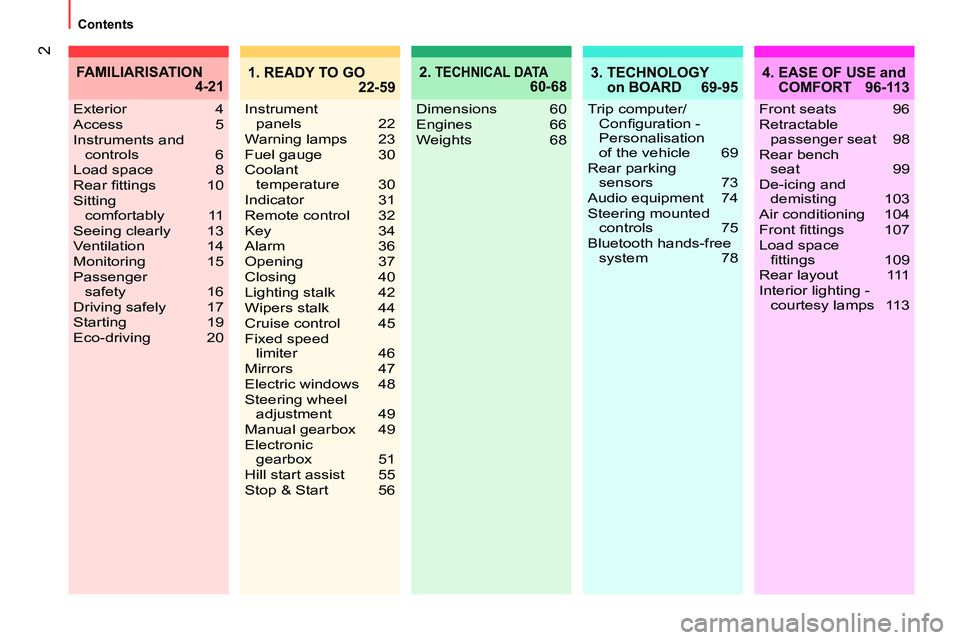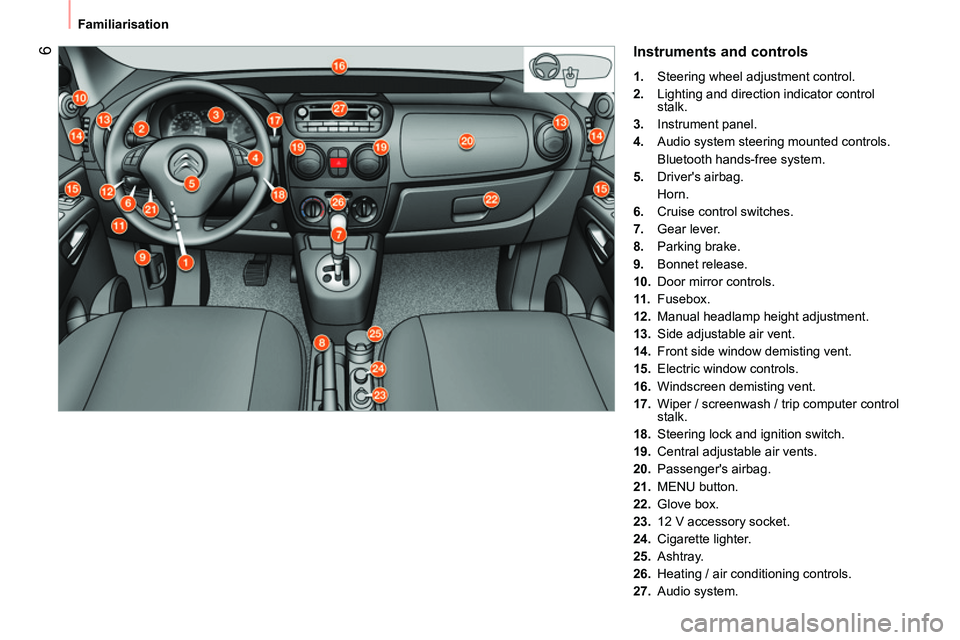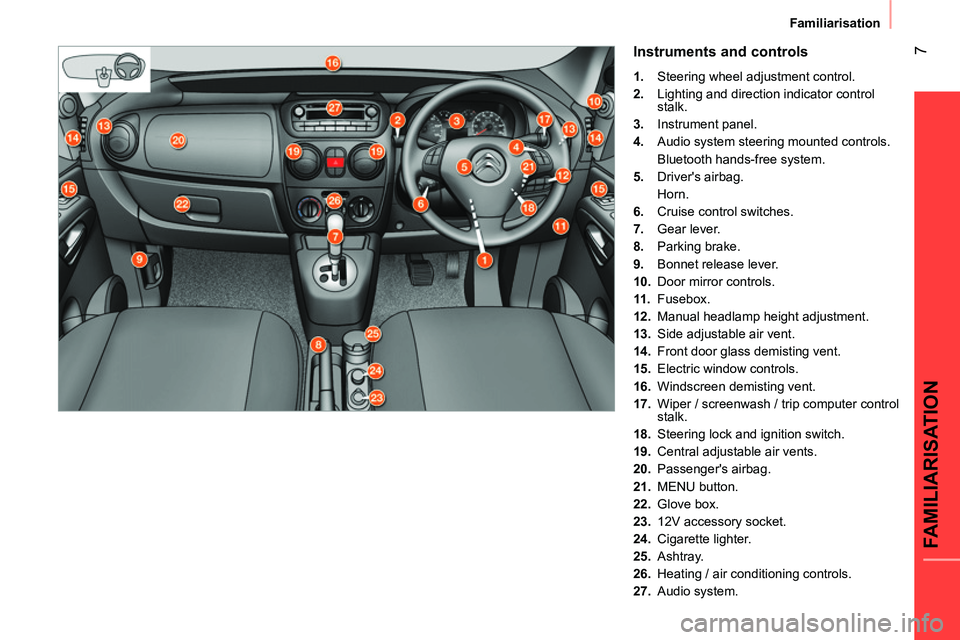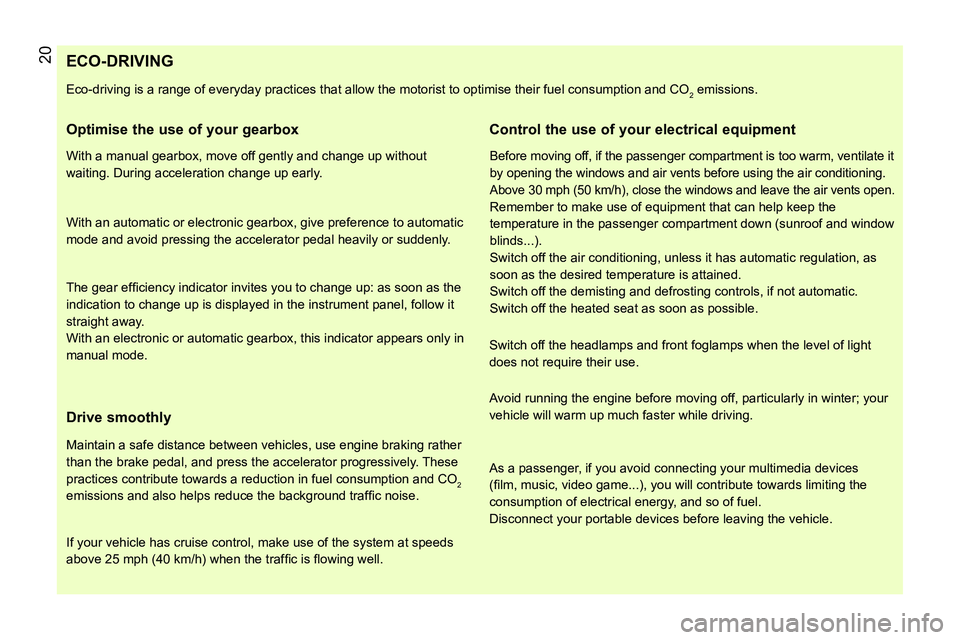air conditioning CITROEN NEMO 2014 Handbook (in English)
[x] Cancel search | Manufacturer: CITROEN, Model Year: 2014, Model line: NEMO, Model: CITROEN NEMO 2014Pages: 192, PDF Size: 10.74 MB
Page 4 of 192

2
Contents
2. TECHNICAL DATA 60-684. EASE OF USE and
COMFORT 96-113
Dimensions 60
Engines 66
Weights 68 Exterior 4
Access 5
Instruments and
controls 6
Load space 8
Rear fi ttings 10
Sitting
comfortably 11
Seeing clearly 13
Ventilation 14
Monitoring 15
Passenger
safety 16
Driving safely 17
Starting 19
Eco-driving 20
FAMILIARISATION
4-21
Front seats 96
Retractable
passenger seat 98
Rear bench
seat 99
De-icing and
demisting 103
Air conditioning 104
Front fi ttings 107
Load space
fi ttings 109
Rear layout 111
Interior lighting -
courtesy lamps 113
3. TECHNOLOGY
on BOARD 69-95
Trip computer/
Confi guration -
Personalisation
of the vehicle 69
Rear parking
sensors 73
Audio equipment 74
Steering mounted
controls 75
Bluetooth hands-free
system 78
1. READY TO GO
22-59
Instrument
panels 22
Warning lamps 23
Fuel gauge 30
Coolant
temperature 30
Indicator 31
Remote control 32
Key 34
Alarm 36
Opening 37
Closing 40
Lighting stalk 42
Wipers stalk 44
Cruise control 45
Fixed speed
limiter 46
Mirrors 47
Electric windows 48
Steering wheel
adjustment 49
Manual gearbox 49
Electronic
gearbox 51
Hill start assist 55
Stop & Start 56
Page 8 of 192

6
Familiarisation
Instruments and controls
1.
Steering wheel adjustment control.
2.
Lighting and direction indicator control
stalk.
3.
Instrument panel.
4.
Audio system steering mounted controls.
Bluetooth hands-free system.
5.
Driver's airbag.
Horn.
6.
Cruise control switches.
7.
Gear lever.
8.
Parking brake.
9.
Bonnet release.
10.
Door mirror controls.
11 .
Fusebox.
12.
Manual headlamp height adjustment.
13.
Side adjustable air vent.
14.
Front side window demisting vent.
15.
Electric window controls.
16.
Windscreen demisting vent.
17.
Wiper / screenwash / trip computer control
stalk.
18.
Steering lock and ignition switch.
19.
Central adjustable air vents.
20.
Passenger's airbag.
21.
MENU button.
22.
Glove box.
23.
12 V accessory socket.
24.
Cigarette lighter.
25.
Ashtray.
26.
Heating / air conditioning controls.
27.
Audio system.
Page 9 of 192

7
FAMILIARISATION
Familiarisation
Instruments and controls
1.
Steering wheel adjustment control.
2.
Lighting and direction indicator control
stalk.
3.
Instrument panel.
4.
Audio system steering mounted controls.
Bluetooth hands-free system.
5.
Driver's airbag.
Horn.
6.
Cruise control switches.
7.
Gear lever.
8.
Parking brake.
9.
Bonnet release lever.
10.
Door mirror controls.
11 .
Fusebox.
12.
Manual headlamp height adjustment.
13.
Side adjustable air vent.
14.
Front door glass demisting vent.
15.
Electric window controls.
16.
Windscreen demisting vent.
17.
Wiper / screenwash / trip computer control
stalk.
18.
Steering lock and ignition switch.
19.
Central adjustable air vents.
20.
Passenger's airbag.
21.
MENU button.
22.
Glove box.
23.
12V accessory socket.
24.
Cigarette lighter.
25.
Ashtray.
26.
Heating / air conditioning controls.
27.
Audio system.
Page 16 of 192

14
Familiarisation
VENTILATION
Recommended interior settings
I require...
Heating or Manual Air Conditioning
Air distribution
Air fl ow
Air recirculation /
Intake of outside air
Temperature
Manual A/C
HOT
COLD
DEMISTING
DEFROSTING
104
Page 22 of 192

20
ECO-DRIVING
Eco-driving is a range of everyday practices that allow the motorist to optimise their fuel consumption and CO2 emissions.
Optimise the use of your gearbox
With a manual gearbox, move off gently and change up without
waiting. During acceleration change up early.
With an automatic or electronic gearbox, give preference to automatic
mode and avoid pressing the accelerator pedal heavily or suddenly.
The gear effi ciency indicator invites you to change up: as soon as the
indication to change up is displayed in the instrument panel, follow it
straight away.
With an electronic or automatic gearbox, this indicator appears only in
manual mode.
Drive smoothly
Maintain a safe distance between vehicles, use engine braking rather
than the brake pedal, and press the accelerator progressively. These
practices contribute towards a reduction in fuel consumption and CO
2
emissions and also helps reduce the background traffi c noise.
If your vehicle has cruise control, make use of the system at speeds
above 25 mph (40 km/h) when the traffi c is fl owing well.
Control the use of your electrical equipment
Before moving off, if the passenger compartment is too warm, ventilate it
by opening the windows and air vents before using the air conditioning.
Above 30 mph (50 km/h), close the windows and leave the air vents open.
Remember to make use of equipment that can help keep the
temperature in the passenger compartment down (sunroof and window
blinds...).
Switch off the air conditioning, unless it has automatic regulation, as
soon as the desired temperature is attained.
Switch off the demisting and defrosting controls, if not automatic.
Switch off the heated seat as soon as possible.
Switch off the headlamps and front foglamps when the level of light
does not require their use.
Avoid running the engine before moving off, particularly in winter; your
vehicle will warm up much faster while driving.
As a passenger, if you avoid connecting your multimedia devices
(fi lm, music, video game...), you will contribute towards limiting the
consumption of electrical energy, and so of fuel.
Disconnect your portable devices before leaving the vehicle.
Page 60 of 192

58
Gearbox and steering wheel
Deactivation
To give precedence to the control
of the temperature in the passenger
compartment, the Stop & Start
system should be deactivated to
allow continuous operation of the air
conditioning.
The system retains the same state
(active or inactive) after switching of
and restarting the engine with the key.
At any time, press the "S - OFF"
switch to
deactivate the system.
This is confirmed by the switch warning lamp
coming on accompanied by a message in
the instrument panel screen.
If the system has been deactivated
in STOP mode, the engine restarts
immediately.
Operating fault
Maintenance
In the event of a fault with the
system, the Stop & Start system
is deactivated and this warning
lamp comes on in the instrument
panel, accompanied by a
message in the instrument panel
screen .
Have it checked by a CITROËN dealer or a
qualified workshop.
In the event of an operating fault with STOP
mode, it is possible to restart the engine by
depressing the clutch pedal fully and putting
the gear lever into neutral. Before working under the bonnet, you
must switch off the ignition with the
key to avoid any risk of injury resulting from
automatic operation of START mode.
This system requires a specific battery
with a special specification and technology
(reference numbers available from a
CITROËN dealer or a qualified workshop).
Fitting a battery not listed by CITROËN
introduces the risk of malfunction of the
system.
The Stop & Start system makes use
of advanced technology. Specialist
knowledge is needed for any work on the
system, which can only be assured by
CITROËN dealers.
Reactivation
Press the "S - OFF"
switch again.
The system is active again; this is confirmed
by the switch warning lamp going off and a
message in the instrument panel screen.
Page 105 of 192

103
4
EASE OF USE and COMFORT
Ventilation
DEMISTING AND DEFROSTING
Windscreen
The vents located at the base of the
windscreen and the side vents for the side
windows increase the effectiveness of the
demisting and defrosting. Do not obstruct
these eight vents.
The manual air conditioning includes a
pollen filter and air recirculation.
The pollen filter permits continuous and
effective filtering of dust.
Air recirculation (which can be operated by
the driver or the passenger) isolates the
passenger compartment from the exterior
atmosphere. However, this position should
only be used temporarily, you should
normally drive with the control in the exterior
air intake position.
Manual mode
Turn the control to this air
distribution setting.
For faster and more effective
demisting and defrosting of the
windscreen:
- increase the air flow setting,
Return to the exterior air intake
position as soon as possible to
allow renewal of the air in the
passenger compartment.
Rear screen and mirrors defrosting
This function only operates when
the engine is running. Pressing
this button activates the rapid
demisting/defrosting of the rear
screen and mirrors. This function switches
off automatically to prevent an excessive
consumption of energy. It switches off when
the engine is switched off. Pressing this
button switches the function off.
- move the exterior air intake
control temporarily to air
recirculation.
Page 106 of 192

104
Ventilation
CORRECT USE OF THE AIR
CONDITIONING
Operate the air conditioning system for
5 to 10 minutes, once or twice a month,
to keep it in perfect working order.
Have the filter elements (air filter and
passenger compartment filter) replaced
regularly. If you drive in a dusty environment,
have them replaced twice as often.
It is normal that the condensation created by
the air conditioning system results in a flow
of water which may form a puddle under the
vehicle when parked.
If the system does not produce cold air, do
not use it and contact a CITROËN dealer or
a qualified workshop.
VENTS
For optimum distribution and diffusion of hot
or cool air in the passenger compartment,
there are:
- 2 adjustable central vents,
- 2 adjustable and closing side vents,
- 2 vents directed towards the floor of the
vehicle.
In order to be effective, the air conditioning
should only be used with the windows
closed. However, if the interior temperature
is high after a prolonged period parked
in the sun, first ventilate the passenger
compartment for a few minutes.
For even air distribution, ensure that the
exterior air intake grille located at the base
of the windscreen is not obstructed and that
the side and central vents, the air outlets on
the floor and the air extractor at the rear are
open.
The air conditioning is useful in all seasons
as it eliminates condensation and air
humidity.
Page 107 of 192

105
4
EASE OF USE and COMFORT
Ventilation
These controls are located on the centre console.
Air conditioning
The air conditioning mode is operational
when the engine is running. The LED is on.
Temperature adjustment
Control positioned:
- in the blue zone delivers
cool air,
Air flow
The air flow fan setting varies
from 1
to the strongest 4
. Adjust
this control in order to reach the
desired level of comfort. To switch
off the fan, place the control in position 0
.
The air distribution is varied
by turning the control turned
towards:
the side vents and the central
vents,
the side vents, the central vents
and the footwells,
the footwells,
the windscreen, the front side
windows and the footwells,
the windscreen. Press the air flow fan control. The
LED comes on.
The air flow fan control must not
be in position 0
(zero flow) for air
conditioning to be obtained.
Turn the control to the position required.
- in the red zone delivers
heating of the interior air.
Air distribution
Page 108 of 192

106
Ventilation
Intake of exterior air
This is the preferred operating
position.
Recirculation of interior air
This position should only be
temporary.
Used with the air conditioning
switched on and using the
appropriate air fan setting (from 1 to 4),
recirculation enables you to obtain the
desired level of comfort with either hot or
cold settings.
Recirculation prevents exterior odours
and smoke from entering the passenger
compartment. Defrosting is faster in this
position.
Once the required level of comfort has been
reached, return to the intake of exterior air
position to permit renewal of the air in the
passenger compartment and demisting. This
is the preferred operating position.